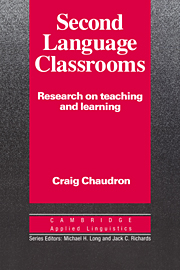Book contents
- Frontmatter
- Contents
- List of tables and figures
- Series editors' preface
- Preface
- 1 Major issues in second language classroom research
- 2 Classroom research methods
- 3 Teacher talk in second language classrooms
- 4 Learner behavior in second language classrooms
- 5 Teacher and student interaction in second language classrooms
- 6 Learning outcomes
- 7 Directions for research and teaching
- References
- Index
6 - Learning outcomes
Published online by Cambridge University Press: 05 October 2012
- Frontmatter
- Contents
- List of tables and figures
- Series editors' preface
- Preface
- 1 Major issues in second language classroom research
- 2 Classroom research methods
- 3 Teacher talk in second language classrooms
- 4 Learner behavior in second language classrooms
- 5 Teacher and student interaction in second language classrooms
- 6 Learning outcomes
- 7 Directions for research and teaching
- References
- Index
Summary
The previous chapters have discussed research on teacher speech – its functions and qualitative or quantitative modifications, learner behaviors in response to instructional activities or interaction with other learners, and classroom interaction phenomena such as questioning and corrective feedback. In several cases, the behaviors described have been linked to L2 learning, so the present chapter will review research on L2 classroom processes that have a potentially positive effect on learners' perception and incorporation of the forms and functions of the target language.
Teacher input and learner comprehension/production
An initial consideration in Chapter 3 was the quantity of teacher talk. Although the typical dominance of teacher speech in classrooms was considered to be undesirable, several classroom studies suggest a relationship between the frequency of certain structures in teacher input and learners' target language development. These will be discussed in a section on frequency of input. A second issue, the principal focus of Chapter 3, dealt with modifications of teacher classroom speech. To what extent might teachers' modifications influence learners' comprehension, and consequently learning? Among the modifications of classroom target language input that were described, two have been investigated with regard to comprehensibility: rate of speech and syntactic complexity. These studies will be considered first.
Rate of speech
Hatch (1983:183) has suggested several benefits of slower speech to L2 learners, among which are especially that it should allow more processing time and clearer segmentation of the structures in the input.
Information
- Type
- Chapter
- Information
- Second Language ClassroomsResearch on Teaching and Learning, pp. 154 - 179Publisher: Cambridge University PressPrint publication year: 1988
Accessibility standard: Unknown
- 1
- Cited by
